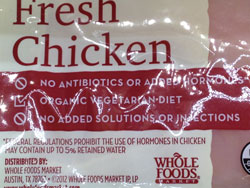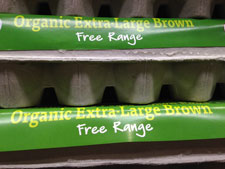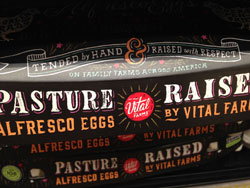Let’s talk about a few marketing techniques and labels, especially as it comes to meat and poultry. These are truthful but misleading at the same time.
 No added growth hormones. A personal favorite. The conversation regarding the use of hormones and antibiotics in meat and poultry is a hot topic. Some big chicken manufactures actually promote the fact that they don’t use any hormones in their chicken. In commercials, you can see in small writing that federal regulations don’t allow the use of hormones in poultry and hogs. So while you think the company is taking steps to protect your health and offer a better solution for your family, they are actually just following the rules. But….and this is a big one, there is no mention of the use of antibiotics in these commercials. So again, you make a purchase based on the marketing of no hormones but at the same time, they don’t tell you if they are using antibiotics. And if a company doesn’t take credit for not using antibiotics, they probably are.
No added growth hormones. A personal favorite. The conversation regarding the use of hormones and antibiotics in meat and poultry is a hot topic. Some big chicken manufactures actually promote the fact that they don’t use any hormones in their chicken. In commercials, you can see in small writing that federal regulations don’t allow the use of hormones in poultry and hogs. So while you think the company is taking steps to protect your health and offer a better solution for your family, they are actually just following the rules. But….and this is a big one, there is no mention of the use of antibiotics in these commercials. So again, you make a purchase based on the marketing of no hormones but at the same time, they don’t tell you if they are using antibiotics. And if a company doesn’t take credit for not using antibiotics, they probably are.- Natural. You see it everywhere. The only standard set for using the word “natural” is for meat and poultry products. This requires that the final product has minimal processing and cannot contain any artificial color, artificial flavors, preservatives or any other artificial ingredients. While that may sound great, they may not be humanely raised or free from hormones (beef) or antibiotics.
 Free Range-Free Roaming. Picture chickens roaming free in a green pasture….maybe not. The USDA does require with this labeling that the animals be giving access to the outdoors. The catch here is that there is no official requirement set for the time they spend outdoors. While outdoor access for chickens is definitely a step in the right direction, this label doesn’t mean they are cruelty-free or antibiotic-free.
Free Range-Free Roaming. Picture chickens roaming free in a green pasture….maybe not. The USDA does require with this labeling that the animals be giving access to the outdoors. The catch here is that there is no official requirement set for the time they spend outdoors. While outdoor access for chickens is definitely a step in the right direction, this label doesn’t mean they are cruelty-free or antibiotic-free. Cage-Free. While this is used on a lot of egg cartons, it does require a bird not be in a cage but does not explain whether a bird is allowed any time outdoors, or if they are raised in overcrowded indoor conditions. Slightly deceiving.
Cage-Free. While this is used on a lot of egg cartons, it does require a bird not be in a cage but does not explain whether a bird is allowed any time outdoors, or if they are raised in overcrowded indoor conditions. Slightly deceiving.
So what to buy?
 If at all possible in your area, start with organic meats and eggs. While organic will avoid GMOs in feed, provides access to outdoor access, no antibiotics or hormone use in animals. If you have the access to pasture raised meats and eggs, that is even better. Pasture raised means that animals are raised on a pasture where they are able to eat nutritious grasses and plants. (Versus grains in others, including organic). Being raised on a pasture means that they are allowed to move freely and carry on normal behaviors.
If at all possible in your area, start with organic meats and eggs. While organic will avoid GMOs in feed, provides access to outdoor access, no antibiotics or hormone use in animals. If you have the access to pasture raised meats and eggs, that is even better. Pasture raised means that animals are raised on a pasture where they are able to eat nutritious grasses and plants. (Versus grains in others, including organic). Being raised on a pasture means that they are allowed to move freely and carry on normal behaviors.
Don’t know if your local market carries these options? Ask. The more they are questioned, the more likely they are to bring in these options.
Even better, find a local farm to get pasture raised meats and poultry. You can find a local farm at http://www.localharvest.org
Resource:
http://www.fsis.usda.gov/wps/portal/fsis/topics/food-safety-education/get-answers/food-safety-fact-sheets/food-labeling/meat-and-poultry-labeling-terms/meat-and-poultry-labeling-terms







